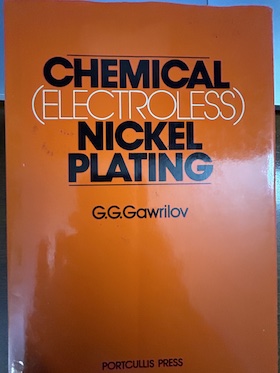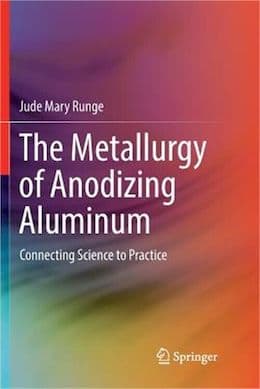
Curated with aloha by
Ted Mooney, P.E. RET

The authoritative public forum
for Metal Finishing 1989-2025

-----
Zincating aluminum for plating
Q. Hi,
We are trying to zincate very tiny Al bond pads on Si chip by using Electroless Zinc Solution. Our aim is to form an Electroless Ni coating on the zinc. But unfortunately we are not getting a smooth finish on the Al bond pads after immersing it in the Electroless Zn solution. Some scattered granules are developing on the Al surface rather than a smooth uniform zincated finish which is affecting the subsequent Ni deposition. Can anybody suggest something to improve the situation?
Actually, the electroless Ni is our main aim. We have been using the Zincating only to form a base for the Electroless Ni. We are ready to discard the Zincating process altogether if any suitable alternative is suggested. Do you think Electroless Ni can be directly deposited on Al?
Thanks and regards,
Madhumita Datta- University of Maryland, Maryland
1997
A. May I suggest that you try a proprietary zincate. Most work well. You might want to use a ternary one such as the one that Gumm and a couple others sell. If you follow their procedures, you should not have a problem. If it is a high silica aluminum, prep with a fluoride in it will probably be necessary.
If you only need lab quantities of it you probably have a problem. Most companies no longer give lab samples out. Most platers can not afford the liability of letting you have a little. I have heard of some that let select people "steal" some.
James Watts- Navarre, Florida
1997
1997
A. I think you should try to get some proprietary zincating solution, I imagine that is what you mean by electroless zinc. The literature gives the proper steps to zincating before electroless nickel, and should give you perfect adhesion. Try "Products Finishing" (USA), December 1969, Techniques for Plating on Aluminum, by M.F. McFadden.
Alkaline clean, rinse, zincate, nitric dip, zincate, rinse, rochelle copper strike, subsequent plate is quite robust.

Tom Pullizzi
Falls Township, Pennsylvania
1997
A. Jim is right, you need a supplier.
First you have to clean the Al, then desmut it, then double zincate it, then I would recommend a flash Electroless Nickel with pH about 8 (to avoid damaging the zincate layer) ... and only then the ordinary electroless plating.

Sara Michaeli
Tel-Aviv-Yafo, Israel
by G. G. Gawrilov

on AbeBooks
or eBay or
Amazon
(affil links)
A. The important thing to realize here is that Madhumita is trying to EN virtually "Chemically pure"(CP) Aluminum wire bond pads on integrated circuits and the Aluminum pad is usually considerably less than 1 mil thick! Therefore all the "usual" corrosion-intensive steps for zincating Aluminum hog-outs and such are not allowed on Aluminum IC bond pads. CP Aluminum is bad enough. Has anyone out there ever tried to get EN to stick to it before? It passivates so fast that wet chemistries usually cannot be used. So in IC processing, if the chip is to be "bumped" with plated metal, the Aluminum vacuum deposition step to form the bond pads is gradually shut off while simultaneously turning on a Gold vacuum deposition step within the same reactor. This gives the bond pad a gradual transition from Al to Au and now the Au surface can be worked by standard wet process. HOWEVER ...finding a method to uniformly apply EN to the (CP)Al bonding pads without the Au transition AND with good adhesion would be a great improvement to what is currently available, and I suspect this is the crux of Madhumita's research. By the way, a few large plating chemical suppliers try to sell "foolproof" proprietaries for this problem but they don't seem to remain stable over time and yield loss ends up killing you.
Regards and best of luck,

Dave Kinghorn
Chemical Engineer
SUNNYvale, California
by Runge & Kaufman

on AbeBooks
or eBay or
Amazon
(affil links)
Q. Dave,
Isn't the whole point of zincating to form a surface that will keep the oxide from forming on Al? Are you saying that zincate or stannate will not form on pure aluminum? I have always worked with "regular, old aluminum" which of course, has lots of impurities. This would be interesting to me if pure aluminum does not react to the treatments.
Why would it be hard to control the normal zincating on 1 mil or even a 1/2 mil of aluminum? Is it the process used in these chips?
thank you,

Tom Pullizzi
Falls Township, Pennsylvania
1997
1998
A. Regarding zincating CP Al, the deposits will form, but adhesion suffers. Therefore direct vacuum methods to get to Au are employed. Another classic method is Cr/Cu deposition followed by Cu/Au plating. There are many other such schemes, but no wet method direct on thin CP Al. With regard to thickness, Al bond pads can be just a few microns thick, therefore the usual corrosion intensive steps of caustic & acid dipping to get a "good" zincated layer will consume the entire bonding pad. Lighter grade surface treatments give poor adhesion. So vacuum methods are still preferred. Perhaps an electronics packaging guru can chime in and explain things better, and hopefully an EN tank jockey from the disk-drive industry can fill us in on the details of plating thin Al substrates.
Regards,

Dave Kinghorn
Chemical Engineer
SUNNYvale, California
Q. Hi!
I'm a Spanish student of electronic engineering; my English skill is poor, I hope you can excuse me.
I'm doing my final career project. It consist in develop a Ni/Au bumping electroless process. Actually I'm doing Ni electroless deposition, but it's wrong. If I do not make a previous exposure to Zn bath, of Al pads, the Ni film is rather irregular but hardly solid. On the other hand, if I make a previous exposure to Zn, the Ni film is great, but poor adhesion on Al.
I have seen that the Ni bath temperature is a critical factor. The temperature bath must be between 90 - 92 °C, but if you can arrive to 94-96 °C without ebullition, the layer film of Ni will be great without a previous Zn bath. Then you can grow a Ni film on Al, perfectly sticked on.
Francesc Paraira Beserstudent - Spain
1999
Q. Hi!
What are the best bath and parameters of zincating the very tiny micro-condensator connectors from low Cu (<1%) Al alloys? The main demands to the Zn coat are the coat uniformity, the low electrical resistance of Al-Zn transition layer and the ability to be a proper pre-coating for the succeeding electroless Ni. We have been facing the unexpected problems with this coating parameters since Cu contents of Al alloy was reduced from 4% to 1% and less.
Thanks and regards,
Vladimir Salman- Ashdod, Israel
2000
Plating on Aluminum: Short zincate solution life
Q. I am looking for information on zincate solution. I am currently plating copper and nickel on aluminum. I am wandering if there is a maximum aluminum level in a zincate solution before the solution is spent? I am presently maintaining my zincate bath by chemical analysis and the aluminum level has risen and now it no longer is working properly. If there is a maximum aluminum level is there any way to reduce this level other than dilution?
Angie Molnar- canada, Alberta
2001
Zincate contamination, Electroless Nickel Plating on Low Quality Aluminum Casting
2005Q. We have recently been requested by a customer to plate some low pressure castings. It seems that this casting method results in greater porosity than the higher pressure methods, and I believe this consequently is giving higher failure rates.
This is our process for these parts (which works quite successfully on other castings):
1. Alkaline clean ~70 °C
2. Double rinse
3. Etch (60 g/l ammonium bifluoride)
4. Rinse
5. Desmut (proprietary formulation)
6. Double rinse
7. Zincate
8. Double rinse
9. Electroless nickel strike (alkaline)
10. Rinse
11. Electroless nickel plate
If anyone could advise on improving the above process to gain a better result on low pressure castings it would be greatly appreciated. Thanks.
Plating Shop - Brisbane, Queensland, Australia

Aluminum How-To
"Chromating - Anodizing - Hardcoating"
by Robert Probert
Also available in Spanish
You'll love this book. Finishing.com has sold almost a thousand copies without a single return request :-)
A. If it is diecast, change step 3 to 50% Nitric Acid plus 1 pound per gallon ammonium bifluoride.
If it is sand cast, change step 3 to 100% Nitric Acid plus 2 pounds per gallon ammonium bifluoride.
Then insert a 4 oz/gal Sodium Bicarbonate, room temperature, between the zincate and the alkaline EN.
Come back and let us know what happened.

Robert H Probert
Robert H Probert Technical Services
Garner, North Carolina

2005
A. You need a double zincate with clean 50% nitric acid between the two dips in zincate.

Sara Michaeli
Tel-Aviv-Yafo, Israel
2005
2005
Yes it will. When you pretreat this casting you will build some bridging. I would recommended a soft pretreatment and also careful rinsing for a longer time than when you are plating other aluminium alloys. I would not recommended what Sara said (to use a second zincate) for this aluminium. With all of the holes under the bridge, contamination from that pretreatment stays left over, and after a time this contamination starts corrosion attack and lifts the plating deposit from the aluminium material.
Regards,

Anders Sundman
4th Generation Surface Engineering
Consultant - Arvika,
Sweden
2005
Q. Hello,
To keep everyone updated, we are still not having success with these parts. However, the supplier is accepting parts with blistering because they need them urgently and their other plating supplier is also unable to plate successfully.
I have tried numerous different approaches including:
- Double zincate
- Using a tri-acid desmut (35% nitric, 25% sulfuric, 120 g/l ammonium bifluoride) in place of the proprietary solution
- Sodium bicarbonate dip before the EN strike
- Immersing parts in hot water after cleaning cycle in an effort to ensure any remaining oils were forced out of capillaries
- Alkaline etch instead of, and in addition to, the bifluoride etc
- Baking parts overnight prior to plating (this was recommended in a book that the representative from our supplier brought when he came to have a look at our issue).
- And many combinations of these variations.
I am starting to think what we have here is effectively an unplateable material. Our customer has drilled into some of the parts to 'open up' the pores in an attempt to help us to rinse them better - I took a piece of thin wire and poked it in to see how deep it went - and some of the pores are almost 2.5 cm (1") deep! I hate to think the amount of solution we are dragging over between processes.
In fact we have an unusual level of zincate failures recently, early in their life. I am wondering whether this could be a related issue, the zincate becoming excessively contaminated due to drag-in.
Any recommendations or assistance would be greatly appreciated!
Plating Shop - Brisbane, Qld, Australia
Treatment &
Finishing of
Aluminium and
Its Alloys"
by Wernick, Pinner
& Sheasby

(note: this book is two volumes)
on eBay or
AbeBooks
or Amazon
(affil links)
A. Hi John. It sounds like you are right that these blobs of swiss cheese are not reliably plateable. You could see whether it is possible to vacuum impregnate them before plating, but if they have 1" deep holes in them, they are garbage and unfit for much whether plated or not, impregnated or not. Ironically, Anders is probably right that even trying to improve the quality of the pretreatment actually lowers it when it means transferring so much waste from tank to tank via the porosity.
How much structural integrity for any purpose does a component have that is chock full of uncontrolled voids? You're not doing yourself a favor even trying to plate it :-(
Regards,

Ted Mooney, P.E.
Striving to live Aloha
finishing.com - Pine Beach, New Jersey
Plating Electroless Nickel on 6061 T6 Machined Aluminum
Q. I have a part that is a machined 6061 T6 aluminum housing. It need to be plated with Electroless Nickel. We have a plater who is having a difficult time with it. He has tried the copper underplate and that didn't work. He has gone to the EN right to the aluminum. This worked better but is still chipping. He is plating according to MIL-STD-26074. He has claimed that with a "clean bath" it should work better. What is the best proven process for EN plate on a 6061 T6 machined aluminum? Is a underplate needed and if so what is it?
Matthew MajerskyProduct Designer - Erie, Pennsylvania
2007
2007
A. Zincating is required before the electroless nickel or the cyanide copper plating. Whether this is an "underplate" is probably a question of semantics, but I'd say it is. Unsolicited advice is often poorly received, perhaps justifiably, but here goes anyway :-)
I believe that you as the product designer probably will not be able to practically solve the problem for your existing plating shop. Your time might be better spent finding a shop that knows how to do it :-)

Ted Mooney, P.E.
Striving to live Aloha
finishing.com - Pine Beach, New Jersey
|
A. The "best" basically calls for an opinion, so here is mine as I have found nothing better. - Navarre, Florida 2007 A. Alkaline Soak Clean---CWR---Alkaline Etch---CWR---30%Nitric Acid---CWR---Dilute Zincate 30 to 45 seconds---CWR---4 oz/gal Sodium Bicarbonate----ALKALINE Electroless Nickel strike 5 to 10 minutes---then you can plate anything and you cannot chisel it off!  Robert H Probert Robert H Probert Technical Services Garner, North Carolina  2007 |
Zincate blistering on aluminum
August 1, 2013Q. I am a Manager of a shop in which we manufacture and plate parts for assembly in the electrical industry.
We manufacture a hinge made of aluminum and the finishing process requires that we tin plate the aluminum. As the parts were coming off the line, we noticed they were badly blistered. Our process for aluminum plating has parts go through a cleaner to remove oils (ENPREP 109), rinse, then Aluma Prep (which is an etch), Nitric acid bath at 40-50%, rinse, another etch (Etch 150), rinse, Nitric acid at 30-40%, and then Zincate-CN, Copper CN, rinse and finally Sn.
I was told by my process techs that the initial nitric is to strip the racks to maintain proper current flow and the second nitric bath is to remove any oxidation from the parts.
The line operator topped to show me that it is in fact the zincate that is blistering. We have not been able to figure out why though I have my suspicions; I am not a chemist or chemical engineer by profession so I am seeking some help here.
It has been suggested here that we wash and bead-blast the parts first...I don't think that would help.
Any suggestions would be helpful. Thanks!
- Auburn, Maine, USA
A. Since you are tin plating anyway, consider using immersion stannate as a prep instead of zincate. Blasting should not be necessary, but if you do it, the blasting media MUST be designated "for aluminum only" so that we do not imbed any iron from the gun parts somebody sneaked in on the night shift.

Robert H Probert
Robert H Probert Technical Services
Garner, North Carolina

August 2, 2013
A. The zincate bath temperature and immersion time are both critical variables. In my experience, a temperature of about 70 °F was best, but too long or too short an immersion time also caused blistering.
A double zincate process can often eliminate blistering.
It is critical that the copper bath be relatively low efficiency, and to enter the bath live (with current on) since the thin layer of zinc will dissolve rapidly, resulting in blisters.
Lyle Kirman
consultant - Cleveland Heights, Ohio
August 5, 2013
February 21, 2014
Q. I have been doing some aluminum plating, on small items, as follows:
1)Zincate
2)Rinse
3)Nitric strip of zincate
4)Rinse
5)Zincate
6)Rinse
7)Copper cyanide (rochelle bath)
8)Rinse
9)acid dip (very soft 5% sulfuric)
10)nickel plate
11)rinse
12)Chromium plate
13)Rinse
With new solution the result is excellent, perfect adhesion, and no rejects. But after some days and work the solution builds up in aluminum and does not work the same; the substrate gets etched and you see some blisters in the copper. I would like to know if there is a way to keep the solution working for a long time?
Any ideas would be appreciated
Thanks
Daniel
Plater - Bucaramanga Santander Colombia
Q, A, or Comment on THIS thread -or- Start a NEW Thread
